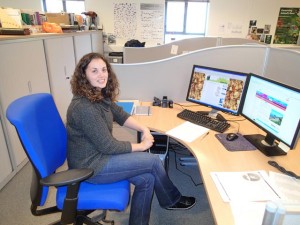
Hi there, I’m Rachel, the new Golf Course Biodiversity Natural Talent Apprentice.
Week one nearly complete, so far so good!
The apprenticeship is based in Northern Ireland and is in partnership with TCV and CEDaR, Department of Natural Sciences, National Museums. If you’re interested in seeing what work CEDaR do check out their web site on the following link www.nmni.com/CEDaR, it’s really worth a look! One of the great things about this apprenticeship is I will have the opportunity to work with both organisations to gain a wide range of skills and knowledge.
So what is my apprenticeship all about? Well, the big picture is the biodiversity of golf courses throughout Northern Ireland and their associated habitat types. There are approximately 94 golf courses throughout NI which host a variety of habitats such as; coastal sand dunes, parkland/woodland, heathland, species rich grasslands, wetlands, ponds and rivers to name but a few. Even the layout of a golf course is enough to get the local birds and bees excited let alone Rory McIlroy! It is the mosaic of fairways, rough and greens with a few bunkers and the odd stream thrown in to test the professional that can provide a haven for a wide variety of flora and fauna, if managed with this in mind.
The debate over the value of golf courses for the natural environment is still pretty much divided among the general public. This is probably due to the fact that, with exception to the research on the ecology of golf courses carried out by the Royal Holloway, University of London, to date there has not been a lot of research carried out on golf courses in the UK. So to consider the pros and cons of golf courses, first off the pros; the rough area is usually relatively unmanaged and can make up a considerable percentage of the whole course, this in itself can provide a substantial wild area for conservation. The rough can act as a wildlife corridor connecting all the habitats on the course and then the course itself can act as a wildlife stepping stone in the wider environment. It has been said that golf courses can provide valuable green spaces in urban areas, and the control of invasive species on the course can benefit the wider environment. Now for the cons; golf courses have the reputation of being highly managed and heavily manicured environments which are uninviting to local wildlife. It is widely perceived that golf courses may destroy areas of natural habitat, chemicals used on the course may cause contamination of the soil and pesticides and fertilisers may contaminate the water bodies on the course.
As I pointed out before there has been little research carried out on golf courses to confirm or dispel these theories. So I guess that is where I come in, during my apprenticeship I will be working closely with Damian McFerran from CEDaR to look at the biodiversity found on different golf courses. I will be collecting data on various species such as Butterflies and moths, invertebrates such as ground beetles, birds will also be considered and the associated vascular plants found on the golf courses. Hopefully we will be able to start building a picture of what is happening on golf courses and then look for comparisons between courses. The past and current management of the golf courses is obviously going to have an effect on the species composition so this will be another factor to consider.
I am sure you are starting to see that this is an important project in terms of research into golf course habitats in Northern Ireland, currently there is no legislation that protects golf courses, neither are they listed as a broad or priority habitat under the UK Biodiversity Action Plan (NIEA 2008). So with this in mind I am eager to get my project up and running and I am very lucky to be so well supported by the staff at CEDaR and TCV.
What am I looking forward to? Getting out and about surveying and working with professionals so I can soak up as much knowledge as I can. Having the opportunity and the time to develop my identification skills over a range of different flora and fauna species and getting to work with enthusiastic people who have a genuine interest in the development of this apprenticeship. I doubt I’ll see many Eagles when I am out surveying but I am sure I will see a few birdies! (Sorry, I couldn’t write this blog without putting in a pun or two).
So that is where am at, I’ll be in touch soon with how it’s all going
Bye for now
Rachel

